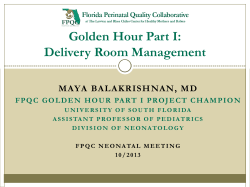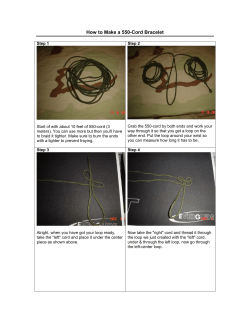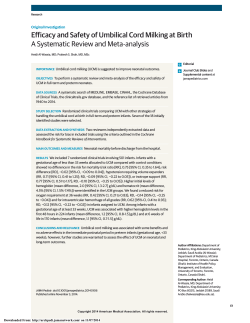
WOMEN AND NEWBORN HEALTH SERVICE 5 INTRAPARTUM CARE 5.9 S
WOMEN AND NEWBORN HEALTH SERVICE King Edward Memorial Hospital CLINICAL GUIDELINES SECTION B : GUIDELINES RELEVANT TO OBSTETRICS & MIDWIFERY 5 INTRAPARTUM CARE 5.9 SECOND STAGE OF LABOUR Date Issued: October 2008 Date Revised: June 2011 Review Date: June 2014 Authorised by: OGCCU Review Team: OGCCU /Infection Control 5.9.4 Birth Management Section B Clinical Guidelines King Edward Memorial Hospital Perth Western Australia 5.9.4.1 BIRTH MANAGEMENT AIM To provide the woman with appropriate care during the second stage of labour. BACKGROUND INFORMATION Different techniques have been used to reduce perineal trauma during vaginal birth. A large study comparing “hands on” or “hands poised” birth techniques noted that the “hands poised” method was associated with lower rates of episiotomy, while the women who had the “hands on” birth technique indicated they experienced less pain in the first 24 hours after delivery, and at 10 days post birth. A smaller more recent study showed no difference in the two techniques.1 KEY POINTS Selection of the birthing technique using the “hands poised’ or ‘hands on” method is determined by the woman and the accoucheur. Episiotomy should be by restrictive use rather than routine use. There are no randomised controlled trials testing the efficacy of suctioning of the pharynx during birth in preventing meconium aspiration syndrome. However an incidental finding in the study by Wiswell et al showed a three fold increase in meconium aspiration syndrome in infants where oropahryngeal suction was not performed. 2At KEMH gentle perineal suction of the baby’s mouth and nose shall be carried out providing this does not delay the birth. Upper airway suctioning shall occur if the baby has thick, tenacious meconium present in the oropharynx or / and when the baby shows any signs of compromise or has depressed vital signs. When the nuchal cord is found to be tightly wrapped around the infant’s neck at birth it should be clamped and cut. Delayed clamping of the umbilical cord in full-term infants may be beneficial.2 In preterm infants delayed clamping is associated with decreased intraventricular haemorrhage and need for transfusions. PREPARATION OF THE AREA AND EQUIPMENT 2008 Check the resuscitation cot to ensure: o The cot is switched on and warmed o Adequate functioning supply of oxygen, air and suction o Laryngoscope – check the function o Nasal/oral intubation tubes and introducers All guidelines should be read in conjunction with the Disclaimer at the beginning of this manual Page 1 of 6 2 heparinised syringes and 21 gauge needles Pre warmed towel – have available for the birth o o Place cord blood bottles within easy access. Check the oxytocic medication and ensure it is prepared for use. Check equipment to be used for birth: o Sterile bowl pack o Instrument pack – including x4 Howard Kelly forceps, x1 episiotomy scissors, x1 cord cutting scissors o Sterile trolley cover o Sterile gloves o Plastic apron, protective glasses/face shield and mask o Sterile cotton wall balls o Sterile large combine pad o Sterile abdominal sponges Ensure equipment is available if required to perform an episiotomy: o 1 x 20mL syringe o 1 x 19 gauge needle o 1 x 22 gauge needle o 10 – 15 mL 0.5% Lignocaine PROCEDURE 1 ADDITIONAL INFORMATION Position of the women for birth Encourage the woman to position herself in the most comfortable position. Evidence remains inconclusive regarding the effectiveness of birth position in preventing perineal trauma.3, 4 The upright position has been shown to cause no adverse effects to the mother or infant; but it has been associated with increased blood loss.5 2 Preparation for the birth 2.1 The accoucheur washes his/her hands and dons: protective full face visor plastic apron mask sterile gloves Date Issued: November 2008 Date Revised: June 2011 Review Date: June 2014 Written by:/Authorised by: OGCCU Review Team: OGCCU 2008 Hand washing removes transient flora preventing transfer from the accoucheur to the woman which may introduce infection.6 A protective full face visor must be worn to minimise the risk of infection from blood and body fluids to the eyes, nose and mouth. Prescription glasses do not provide adequate protection.7 5.9.4 Birth Management Section B Clinical Guidelines King Edward Memorial Hospital Perth Western Australia All guidelines should be read in conjunction with the Disclaimer at the beginning of this manual Page 2 of 6 2.2 At the discretion of the accoucheur, clean the genital area using swabs soaked in warm tap water. A wound caused by accidental or deliberate trauma to the skin breaks down the chemical and mechanical defence for preventing infection in the body.6 There is no evidence that using tap water to cleanse acute wounds increases infection and there is some evidence to indicate it reduces it8. 2.2 2.3 2.4 Separate the labia majora with the non dominant hand, and use the other hand to swab downward from the urethral orifice towards the anus. Consider placing a drape under the woman’s buttocks if the situation permits. The drape provides a clean area to place equipment that may be needed, and reduces the transmission of infectious organisms. Consider placing a clean pad over the anal area. May provide a barrier to prevent soiling by faecal material. 2.5 Assemble equipment for the birth and place within easy reach. 2.6 Prepare a syringe with local anaesthesia when an episiotomy may be needed. 2.7 Organise for a RMO and /or paediatriac registrar to be present at the birth as required. See Clinical Guidelines Section B 5.9.4.3 Labour and Birth Suite quick reference guide to Paediatrician attendance for at risk births 3 Birth of the head 3.1 Hands on Approach 3.2 Place fingers on the advancing head to maintain flexion and control. Allows monitoring of descent and prevents rapid descent with crowning and extension which could cause perineal trauma.7 Support the perineum with the fingers Assists prevention of perineal trauma7, and may reduce puerperal perineal pain.9 Check for cord around the infant’s neck. If tightly wound around the neck, apply 2 Howard Kelly clamps approximately 3cm apart and cut the cord between the clamps. Unwind the cord. Hands off Approach The accoucheur shall have his/her hands poised ready to touch the head of the baby and guard the perineum if necessary 4 If rapid expulsion of the head is occurring then the accoucheur will be able to apply light pressure to the head. Birth of the shoulders and body Date Issued: November 2008 Date Revised: June 2011 Review Date: June 2014 Written by:/Authorised by: OGCCU Review Team: OGCCU 2008 See Clinical Guidelines Section B 5.9.3.1 Infiltration of the Perineum and Cutting of an Episiotomy 5.9.4 Birth Management Section B Clinical Guidelines King Edward Memorial Hospital Perth Western Australia All guidelines should be read in conjunction with the Disclaimer at the beginning of this manual Page 3 of 6 4.1 4.2 Hands on approach Allow internal rotation of the shoulders and trunk and restitution of the head. Place a hand on each side of the infant’s head, then apply gentle downward traction to delivery the anterior shoulder.7 Allows the anterior shoulder to slip beneath the symphysis pubis.7 As the auxiliary crease is seen, guide the head and trunk in an upward curve.7 Allows the posterior shoulder to escape over the perineum.7 Support the infant’s body and assist placing the infant on the mother’s abdomen (skin-to-skin) if she wishes. Permits the mother immediate sighting of her baby.7 Note the time of birth. Ensure a warm cover is placed over the infant. Prevents cooling of the infant.7 Hypothermia causes a worsening of hypoxia by diverting oxygen and glucose from vital centres in order to create heat for survival.10 Hands off approach Allow the shoulders to birth spontaneously. 5 Clamping and cutting the cord Clamp and cut the cord after birth of the baby Decision for early or delayed clamping and cutting of the cord is determined by: Fetal condition Maternal condition Requirement for early blood collection See Clinical Guideline Section B 5.14.1 Umbilical Cord Collection/analysis. See Clinical Guideline Section B 5.14.4 Collection of Cord Blood for Stem Cell Harvest. Applying a swab over the cord prior to cutting may prevent blood spraying.10 Delay in umbilical cord clamping in full term infants for a minimum of 2 minutes following birth improves the long and short term haematological and iron status for the newborn and extends into infancy. The associated increase in polycythaemia appears to be benign2, 11. Delayed clamping may increase the risk for jaundice requiring phototherapy.12 Early cord clamping is performed in situations requiring prompt treatment of the infant or harvesting of stem cells.13 It may increase Rh-sensitization.14 Trials have not shown any difference in post partum haemorrhage rates when comparing early or delayed cord clamping.12 Umbilical cord blood gas and lactate results have been shown to be sensitive to delayed sampling procedures.13 Pre term infants with delayed cord clamping for 30 to 120 seconds appear to be associated with less need for transfusions and experience less intraventricular haemorrhages.14, 15 Date Issued: November 2008 Date Revised: June 2011 Review Date: June 2014 Written by:/Authorised by: OGCCU Review Team: OGCCU 2008 5.9.4 Birth Management Section B Clinical Guidelines King Edward Memorial Hospital Perth Western Australia All guidelines should be read in conjunction with the Disclaimer at the beginning of this manual Page 4 of 6 6 PROCEDURE ADDITIONAL INFORMATION Nasopharyngeal suction can be administered in the presence of meconium stained amniotic fluid or excessive mucus.7 Most infants do not require airway clearance at birth. If suction is required it is recommended that suction of the oropharynx is done prior to the nasopharynx. This prevents mucus and other material being drawn into the respiratory tract should the infant gasp with nasal suction.10 Suction Excessive suction can cause vagal stimulation resulting in laryngospasm and bradycardia.10 7 Apgar Scores The Apgar score should be done at one (1) minute, and five (5) minutes after the birth. 8 The 1 minute Apgar score guides management of resuscitation, while the 5 minute Apgar score is more reliable for predicting risk of death within the first 28 days of life, and for neurological outcomes and risk of disability at the infants first year of age.10 Administering an oxytocic See Clinical Guideline Section B 5.10.1 Active management See Clinical Guidelines Section B 5.10.2 Guidelines for the Use of Syntometrine 9 Episiotomy See Clinical Guideline Section B 5.9.3.1 Infiltration of the perineum and cutting an episiotomy 10 Evidence supports the use of restrictive rather than routine use of episiotomy.16 Indications for use include fetal heart rate anomalies, maternal exhaustion or distress, or if the perineum is restricting progress.17 Third Stage See: Clinical Guideline Section B 5.10.1 Active management Clinical Guideline Section B 5.10.3 Expectant (Physiological) Management Clinical Guideline Section B 5.10.4 Retained placenta Date Issued: November 2008 Date Revised: June 2011 Review Date: June 2014 Written by:/Authorised by: OGCCU Review Team: OGCCU 2008 5.9.4 Birth Management Section B Clinical Guidelines King Edward Memorial Hospital Perth Western Australia All guidelines should be read in conjunction with the Disclaimer at the beginning of this manual Page 5 of 6 PROCEDURE 11 ADDITIONAL INFORMATION Documentation Document the birth details. See Clinical Guidelines Section B 5.17 Notification of Birth Document additional information on the MR 250 Integrated progress notes. REFERENCES 1. De Souza Caroci da Costa A, Gonzalez Riesco ML. A Comparison of "Hands Off" Versus "Hands On" Techniques for Decreasing Perineal Lacerations During Birth. Journal of Midwifery & Women's Health. 2006;51(2):106-11. 2. Hutton EK, Hassen ES. Late vs Early Clamping of the Umbilical Cord in Full-term Neonates. Systematic Review and Meta-analysis of Controlled Trials. JAMA. 2007;297(11):1241-52. 3. Gupta JK, Hofmeyr GJ, Smyth R. Position in the second stage of labour for women without epidural analgesia. Cochrane Database of Systematic Reviews. 2004(1). 4. Soong B, Barnes M. Maternal Position at Midwife-Attended Birth and Perineal Trauma: Is There an Association. Birth. 2005;32(3):164-9. 5. Gupta JK, Hofmeyr G, Smyth R. Position in the second stage of labour for women without epidural anaesthesia. Cochrane Database of Systematic Reviews. 2004(1). 6. Parker L. Applying the principles of infection control to wound care. British Journal of Nursing. 2000;9(7). 7. Infection Control Policy 2.1 Standard Infection Control Precautions. OSH Act 1984. 8. Fernandez R, Griffiths R. Water for wound cleansing. Cochrane Database of Systematic Reviews. 2008(1). 9. Hofmeyr GJ. Evidence-based intrapartum care. Best Practice & Research Clinical Obstetrics and Gynaecology. 2005;19(1):103-15. 10. Farrell P, Sittlington N. The Newborn Baby. In: Fraser DF, Cooper MA, editors. Myles Textbook for Midwives. 14th ed. London: Churchill Livingston; 2003. 11. Chaparro CM, Neufeld LM, Alavex GT, et al. Effect of timing of umbilical cord clamping on iron status in Mexican infants: a randomised controlled trial. Lancet. 2006; June 17 367(9527):1997-2004. 12. MacDonald S, Middleton P. Effect of timing of umbilical cord clamping of term infants on maternal and neonatal outcomes. The Cochrane Database of Systematic Reviews. 2008(2). 13. Wiberg N, Kallen K, Olofsson P. Delayed umbilical cord clamping at birth has effects on arterial and venous blood gases and lactate concentrations. British Journal of Obstetrics and Gynaecology. 2008;115:697-703. 14. Levy T, Blickstein I. Timing of cord clamping revisited. Journal of Perinatal Medicine. 2006;34:293-7. 15. Rabe H, Reynolds G, Diaz-Rossello J. Early versus delayed umbilical clamping in preterm infants. The Cochrane Database of Systematic Reviews. 2004(4). 16. Carroli G, Belizan J. Episiotomy for vaginal birth. The Cochrane Database of Systematic Reviews. 1999(3). 17. Baston H. The second stage of labour. The Practising Midwife. 2004;7(3):30-6. Date Issued: November 2008 Date Revised: June 2011 Review Date: June 2014 Written by:/Authorised by: OGCCU Review Team: OGCCU 2008 5.9.4 Birth Management Section B Clinical Guidelines King Edward Memorial Hospital Perth Western Australia All guidelines should be read in conjunction with the Disclaimer at the beginning of this manual Page 6 of 6
© Copyright 2024


















